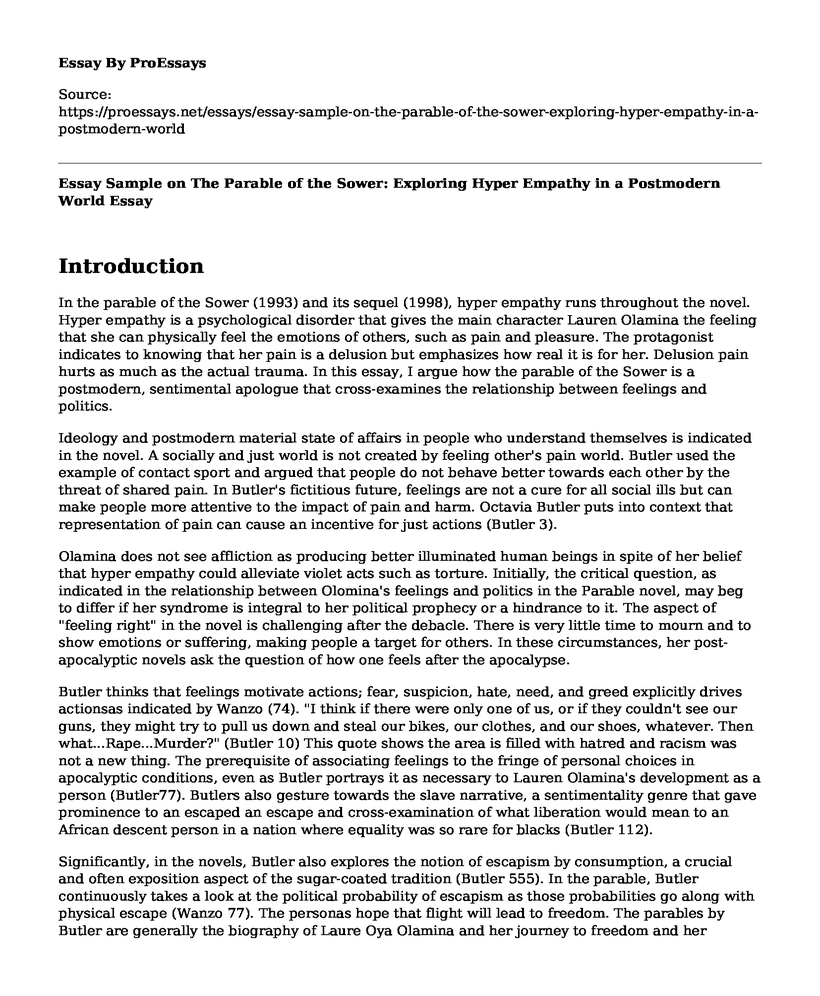Introduction
In the parable of the Sower (1993) and its sequel (1998), hyper empathy runs throughout the novel. Hyper empathy is a psychological disorder that gives the main character Lauren Olamina the feeling that she can physically feel the emotions of others, such as pain and pleasure. The protagonist indicates to knowing that her pain is a delusion but emphasizes how real it is for her. Delusion pain hurts as much as the actual trauma. In this essay, I argue how the parable of the Sower is a postmodern, sentimental apologue that cross-examines the relationship between feelings and politics.
Ideology and postmodern material state of affairs in people who understand themselves is indicated in the novel. A socially and just world is not created by feeling other's pain world. Butler used the example of contact sport and argued that people do not behave better towards each other by the threat of shared pain. In Butler's fictitious future, feelings are not a cure for all social ills but can make people more attentive to the impact of pain and harm. Octavia Butler puts into context that representation of pain can cause an incentive for just actions (Butler 3).
Olamina does not see affliction as producing better illuminated human beings in spite of her belief that hyper empathy could alleviate violet acts such as torture. Initially, the critical question, as indicated in the relationship between Olomina's feelings and politics in the Parable novel, may beg to differ if her syndrome is integral to her political prophecy or a hindrance to it. The aspect of "feeling right" in the novel is challenging after the debacle. There is very little time to mourn and to show emotions or suffering, making people a target for others. In these circumstances, her post-apocalyptic novels ask the question of how one feels after the apocalypse.
Butler thinks that feelings motivate actions; fear, suspicion, hate, need, and greed explicitly drives actionsas indicated by Wanzo (74). "I think if there were only one of us, or if they couldn't see our guns, they might try to pull us down and steal our bikes, our clothes, and our shoes, whatever. Then what...Rape...Murder?" (Butler 10) This quote shows the area is filled with hatred and racism was not a new thing. The prerequisite of associating feelings to the fringe of personal choices in apocalyptic conditions, even as Butler portrays it as necessary to Lauren Olamina's development as a person (Butler77). Butlers also gesture towards the slave narrative, a sentimentality genre that gave prominence to an escaped an escape and cross-examination of what liberation would mean to an African descent person in a nation where equality was so rare for blacks (Butler 112).
Significantly, in the novels, Butler also explores the notion of escapism by consumption, a crucial and often exposition aspect of the sugar-coated tradition (Butler 555). In the parable, Butler continuously takes a look at the political probability of escapism as those probabilities go along with physical escape (Wanzo 77). The personas hope that flight will lead to freedom. The parables by Butler are generally the biography of Laure Oya Olamina and her journey to freedom and her attempts to free others.
Butler portrays escapism as a consistent desire object, the novel revolves around the cycle of imprisonment and escapism, having in mind that escapism cannot be permanent in this world. The book goes into details of Olamina's first imprisonment in a secluded community in California, where she gets showered love and privileges; but too often intimidated by the violet intrusion into the outside world outside her walls. Her surroundings are one that she doesn't want to escape. She is comfortably safe in the walls of her imprisonment, but she very well knows that the walls will fall one day, and departing will be inescapable (Butler 78).
She hides into Christianity, hoping for some sense of salvation the religion promises. Little she realizes that the Christian God neither produces salvation for her and her family as invaders kill most of her family members. The invaders not only broke into their houses but maltreated the women and all-female children and killed every living soul. Olamina's needs for flight increases; she escapes and heads north. She gathers orphans and other adults on her perilous trek. She finds a community based on the principles of earth seed. In conclusion, Butler's novel illuminates most aspects of our daily lives; empathy is essential as a means of human survival
Works Cited
Butler, Octavia E. Parable of the sower. New York: Warner Books, 1995.Print.
Wanzo, Rebecca A. "Apocalyptic Empathy: A Parable of Postmodern Sentimentality." (2005).
Cite this page
Essay Sample on The Parable of the Sower: Exploring Hyper Empathy in a Postmodern World. (2023, Mar 04). Retrieved from https://proessays.net/essays/essay-sample-on-the-parable-of-the-sower-exploring-hyper-empathy-in-a-postmodern-world
If you are the original author of this essay and no longer wish to have it published on the ProEssays website, please click below to request its removal:
- William Shakespeare's Venus and Adonis: Red and White
- Change, Growth, and Development of Wing Biddlebaum/Adolph Myer and Kacem
- Literary Analysis of "To His Coy Mistress" Essay
- "Love in L.A." Clash of Culture Theme Analysis Essay
- Michael Radford's "1984" and George Orwell's "Nineteen Eighty-Four" Essay
- James Baldwin, Hemingway, and Mental Exile in the Metropolis - Research Paper
- Essay Sample on Racism in Maycomb: Whites' Superiority and Blacks' Oppression







